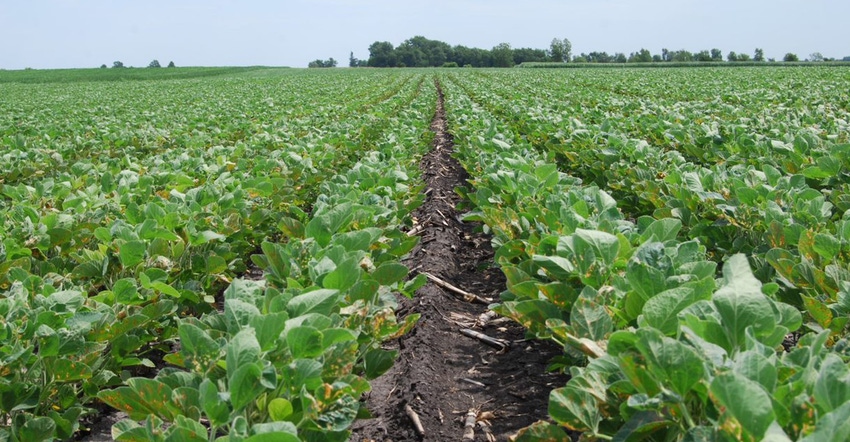June 25, 2019

The old saying “honesty is the best policy” is often attributed to Benjamin Franklin and is sound advice. But he probably never had a bunch of soybean farmers — that had already been through the wringer — wondering what the next kick in pants from Mother Nature would be.
So, when I’m trying to figure out how to talk about challenges these later-planted beans may face, it’s tempting to sugarcoat it a little. Leave it to Mark Twain to bail me out with his wisdom: “Honesty is the best policy, when there is money on it.”
Later-planted beans face challenges right out of the gate since they’re often smaller, have less root growth and have fewer nodes. The likelihood of hitting reproductive stages later in the season also means shorter and fewer days for seed fill.
With capturing as much available sunlight as possible being the short and simple version of what makes soybeans yield well, we need to watch out for anything that can further compromise our fields. Investing more time and resources scouting and possibly protecting bean fields when yields (and markets) aren’t pretty isn’t much fun to talk about, but like Mark Twain mentioned, there may be money on it.
Diseases to watch for this year
Bean fields hitting reproductive stages later than usual this growing season could also be tough news when it comes to diseases. The earlier a plant disease occurs during grain fill, the more likely it is to negatively impact yield. We’ve talked before about the disease triangle — where the host, environment and pathogen all interact to impact potential disease pressure. If we continue to have a wetter-than-usual season as predicted, that sort of environment increases the odds of disease.
Foliar diseases like septoria brown spot, cercospora and frogeye come to mind since they are more common, but there are others to watch for. So take your favorite scouting app or field guide with you.
Often, if these foliar diseases stay in the lower third of the canopy, they don’t impact yield. If they head into the middle third of the canopy, then we start to take notice. If your scouting finds this happening, work with your local agronomist to positively identify the disease and determine if fungicide application is needed. Like we talked earlier, protecting the canopy to capture sunlight is more important than ever in a year like this.
Iowa State University’s Alison Robertson and Daren Mueller discussed white mold in a recent ICM News article, and mentioned a valuable tool developed by the University of Wisconsin-Madison that may come in handy if it is cool and wet during flowering.
Called “Sporecaster,” it can help you assess the risk of white mold development and determine if spraying a foliar fungicide might be necessary. See ipcm.wisc.edu/apps/sporecaster.
Threat of defoliator insects
Calls have already started to come in about caterpillars chomping on beans and reportedly pushing defoliation levels near economic thresholds, not something we typically have to contend with most years. Seeing higher-than-usual numbers of thistle caterpillars or green cloverworms now may not mean we have to spray now or later in the season, but it sure is another reason to scout regularly.
Another defoliator to keep an eye on are Japanese beetles. With degree days accumulating slower this year, we started seeing them in southern Iowa about seven to 10 days later than the last few years. We don’t know how much of an issue they’ll be, but if they do become problematic, their later-than-usual emergence could be significant since most of our beans will be in reproductive stages by early July. While the economic threshold for soybeans is 30% defoliation across the whole field in vegetative stages, it drops to 20% in the reproductive stages.
These defoliation levels — which apply to all the chewing-type insects we fight in beans — seem straightforward on paper. In the field, not so much. It’s easy to be shocked by upper-canopy defoliation, overestimate the amount in general and want to get even with the insects by spraying as soon as possible.
With our beans being behind and probably smaller than usual, we want to protect our canopy if we hit 20%; however, we don’t want to make any more spray trips than we have to. Luckily, ISU’s Erin Hodgson put together a great set of guidelines and graphics to help better estimate defoliation. Read Scouting guidelines for soybean defoliators.
Keep an eye out for aphids
Defoliators aren’t the only critters that might be harder on our later-maturing beans. While they may not be an issue every summer, soybean aphids can cause major yield loss in short order during periods of optimal reproduction.
With our beans already behind in development, an aphid outbreak could hit them harder than usual. We haven’t had a big statewide outbreak for a few years now, so hopefully that trend will continue. On the other hand, more than a few agronomists and farmers have mentioned it feels like we are overdue.
Weekly scouting through mid-seed set (R5.5) is the key. Mid-seed set is likely going to be pushed later in a lot of fields. If the average number of aphids exceeds 250 per plant on about 80% of the soybeans, and populations are increasing prior to hitting R5.5 growth stage, it typically justifies an insecticide application.
This year may bring some other surprises. Vigilant scouting should help you stay ahead of whatever insect might hit.
As we wrap up planned postemerge herbicide applications, scouting is critical in evaluating how well our weed management programs performed. Hopefully, they worked well. But even in the best of conditions, we can have weed escapes. Did I mention that with the weather challenges we had this year, scouting is critical? Locating potential weed escapes and identifying the offenders is just part of the equation.
Follow label directions
When considering any rescue applications, read and follow the herbicide labels. Restrictions on weed size, crop height or stage, product use rates, application timing, and rotational restrictions are just a few of the issues we can run into with resprays. Scouting is the only way to gather some of that information. This is one of those years where we have to scout and stage our beans carefully. While beans might be small, and it may look like we could do a respray within label restrictions, odds are we can’t.
It hasn’t been the most fun year we’ve had so far. OK, that was sugarcoating it too much, It’s time for Mark Twain’s advice and shoot straight. I’m just guessing on the issues mentioned above based on the late planting and cruddy weather, yet hoping to be wrong and that none of them materialize. While it takes time and resources, scouting is the best way to stay a step or two ahead of whatever may show up in our fields.
McGrath is the research and Extension coordinator for the Iowa Soybean Research Center at Iowa State University. Email him at [email protected].
About the Author(s)
You May Also Like






